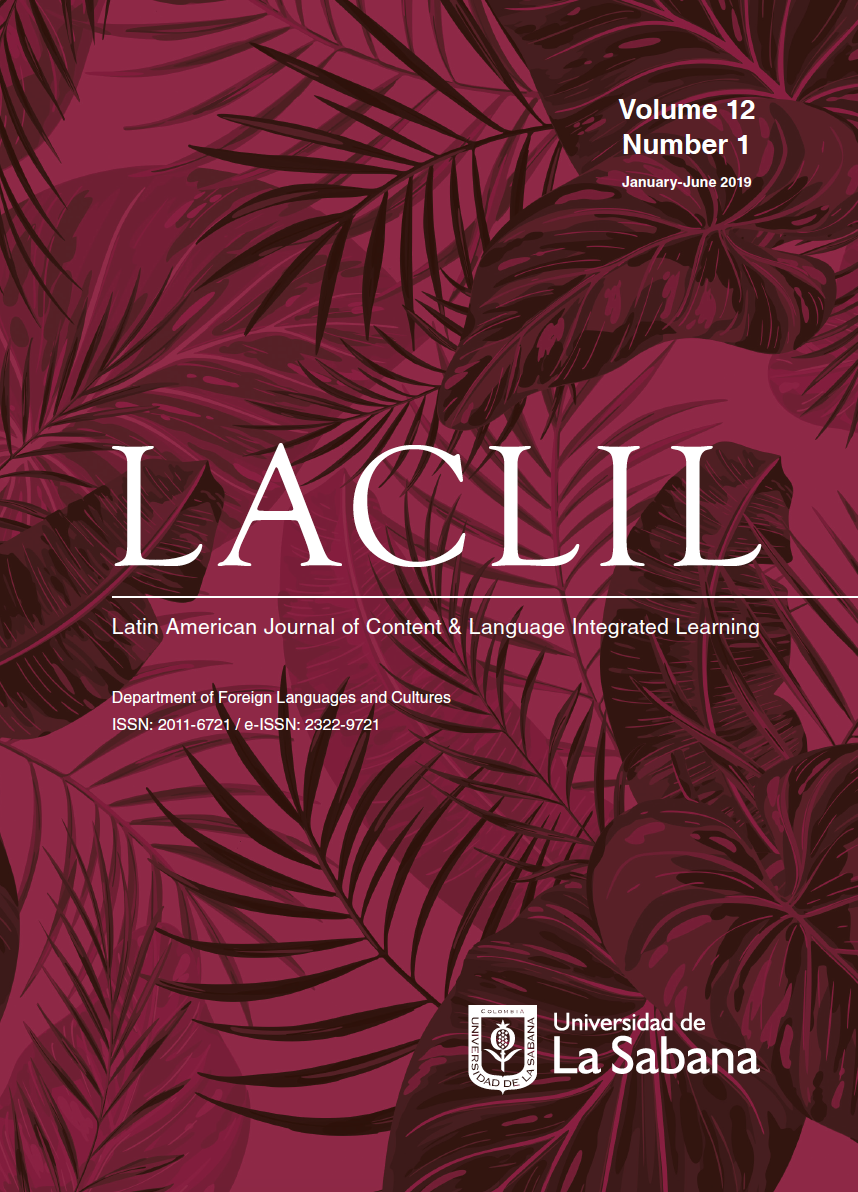The Role of English Language for High-Achieving Mayan Students in the Yucatan Region, Mexico
DOI:
https://doi.org/10.5294/laclil.2019.12.1.3Keywords:
English, Maya, middle schools, academic achievement, high achievers, second language instruction, bilingual education.Abstract
El rol del idioma inglés en estudiantes de alto rendimiento en la zona maya de Yucatán, México
O papel da língua inglesa em estudantes de alto desempenho na área maia de Yucatán, México
The purpose of this research was to identify the role of the level of proficiency in the English language with high-performing third-year students in the Mayan area of Yucatán, near a tourist region called the Riviera Maya. The aim was also to explore the relationship between learning a second language and the subsequent overall improvement in the academic performance of students. These 114 high-achieving students were selected from 1177 students who had taken a standardized English test administered in seven middle schools in the region. Subsequently, individual interviews were conducted with the 21 students with the highest level of English and a focus group of ten students with low-level scores. The results showed an improvement in the English language, as well as its influence in reaching academic prowess in other subjects. This initial study indicated that the reinforcement of English language skills had broader benefits on other academic performance.
To reference this article (APA) / Para citar este artículo (APA) / Para citar este artigo (APA)
Pat, M. A., & Sánchez, P. A. (2019). The role of English language for high-achieving Mayan students in the Yucatan region, Mexico. LACLIL, 12(1), 46-71. DOI: https://doi.org/10.5294/laclil.2019.12.1.3
Received: 13/04/2019
Approved: 22/08/2019
Downloads
References
Barrantes, L. (2015). ¿Cómo establecer un puente entre la teoría de adquisición de las segundas lenguas y la justicia social? Letras, 195–212. Retrieved from https://www.revistas.una.ac.cr/index.php/letras/article/view/8636
Bayliss, A. (2006). IELTS as a predictor of academic language performance. Australian International Education Conference (pp. 1–12). Retrieved from https://pdfs.semanticscholar.org/545d/f30dada9c00f1029b812db812e799ba9e8a8.pdf
Chávez, B., Zacatelco, F., & Acle, G. (2014). ¿Quiénes son los alumnos con aptitud sobresaliente? Análisis de diversas variables para su identificación. Actualidades Investigativas en Educación, 14(2), 1–32. DOI: https://doi.org/10.15517/aie.v14i2.14828
Creswell, J., & Plano, V. (2007). Designing and conducting mixed methods research. Thousand Oaks, CA: SAGE.
CONEVAL, C. N. (2010). Informe anual sobre la situación de pobreza y rezago social. Retrieved from https://www.gob.mx/cms/uploads/attachment/file/47235/Yucatan_102.pdf
Edel, R. (2003). El rendimiento académico: concepto, investigación y desarrollo. REICE. Revista Iberoamericana sobre Calidad, Eficacia y Cambio en Educación, 1(2). Retrieved from https://revistas.uam.es/index.php/reice/article/view/5354
Education First. (2018). EF SET. Retrieved from https://www.efset.org/es/faq/
Friesen, D., Latman, V., Calvo, A., & Bialystok, E. (2015). Attention during visual search: The benefit of bilingualism. The international journal of bilingualism: cross-disciplinary, cross-linguistic studies of language behavior, 693–702. DOI: https://dx.doi.org/10.1177/1367006914534331
Hamui-Sutton, A. (2013). Un acercamiento a los métodos mixtos de investigación en educación médica. Investigación en Educación Médica, 2(8), 211-216. Obtenido de http://www.redalyc.org/articulo.oa?id=349733226006
Hays, B. (2016, September 9). Learning, speaking a second language aids attention and focus. Retrieved from https://www.upi.com/Science_News/2016/09/09/Learning-speaking-a-second-language-aids-attention-and-focus/8891473437511/
INEGI. (2015a). Encuesta intercensal. Retrieved from http://www.beta.inegi.org.mx/app/areasgeograficas/?ag=31#tabMCcollapse-Indicadores
INEGI. (2015b). Panorama sociodemográfico de Yucatán 2015. Retrieved from http://coespo.yucatan.gob.mx/general/31_Panorama_Yuc.pdf
Jiménez, C., & Álvarez, B. (1997). Alumnos de alta capacidad y rendimiento escolar insatisfactorio. Revista de Educación, (313), 279–295. Retrieved from http://www.mecd.gob.es/dctm/revista-de-educacion/articulosre313/re3131300461.pdf?documentId=0901e72b81272c1a
Jornet, J. (2017). Evaluación estandarizada. Revista Iberoamericana de Evaluación Educativa, 10(1), 5–8. Retrieved from https://revistas.uam.es/index.php/riee/article/viewFile/7590/7890
Jornet, J., & Suárez, J. (1996). Pruebas estandarizadas y evaluación del rendimiento: usos y características métricas. Investigación Educativa, 14(2), 141–163. Recuperado de https://www.uv.es/gem/archivos/RIE14.PDF
Krashen, S. (1984). Second language acquisition and second language learning. Exeter, CA: Pergamon Institute of English.
Krashen, S. (2003). Explorations in language acquisition. Portsmouth, NH: Heinemann.
Krippendorff, K. (1990). Metodología de análisis de contenido: teoría y práctica. Barcelona, Spain: Grupo Planeta.
Leikin, M. (2013). The effect of bilingualism on creativity: Developmental and educational perspectives. International Journal of Bilingualism, 431–447. DOI: https://doi.org/10.1177/1367006912438300
Marian, V., & Shook, A. (2012, October 31). The Dana foundation. Retrieved from http://dana.org/Cerebrum/2012/The_Cognitive_Benefits_of_being_Bilingual/
Mexicanos Primero. (2015). Sorry. Aprendizaje del inglés en México. Retrieved from http://www.mexicanosprimero.org/images/stories/sorry/Sorry-digital-ok.pdf
Montes, I., & Lerner, J. (2011). Rendimiento académico de los estudiantes de pregrado de la Universidad EAFIT. Retrieved from http://www.eafit.edu.co/institucional/calidad-eafit/investigacion/Documents/Rendimiento%20Ac%C3%A1demico-Perrspectiva%20cuantitativa.pdf
Rámirez, J., & Sayer, P. (2016). The teaching of English in public primary schools in Mexico: More heat than light? Archivos Analíticos de Políticas Educativas, 24, 1–22. Arizona State University. Arizona, United States of America. Retrieved from http://www.redalyc.org/pdf/2750/275043450125.pdf
Ramírez, J., Pamplón, E., & Cota, S. (2012). Problemática de la enseñanza del inglés en las primarias públicas de México: una primera lectura cualitativa. Revista Iberoamericana de Educación, 2–12. Retrieved from https://rieoei.org/historico/deloslectores/5020Ramirez.pdf
Ramirez, L., Pérez, C., & Lara, R. (2017). Panorama del sistema educativo mexicano en la enseñanza del idioma inglés como segunda lengua. Revista de Cooperación, 15–21. Retrieved from http://revistadecooperacion.com/numero12/012-02.pdf
Ricoy, M., & Álvarez, S. (2016). La enseñanza del idioma inglés en la educación básica de personas jóvenes y adultas. Revista Mexicana de Investigación Educativa, 385–409. Retrieved from https://www.redalyc.org/pdf/140/14045395003.pdf
Secretaria de Educación Pública. (2017). Modelo educativo para la educación obligatoria. Retrieved from https://www.gob.mx/cms/uploads/attachment/file/207252/Modelo_Educativo_OK.pdf
Stern, H. (1983). Fundamental concepts of language teaching. Oxford, UK: Oxford University Press.
Tarver, S., & Curry, J. (1992). Gifted students in regular classrooms. In L. Cohen (Ed.), Children with exceptional needs in regular classrooms. Chapter 8. Washington, D.C.: National Education Association of the United States.
Tashakkori, A., & Teddlie, C. (2003). Handbook of mixed methods in social & behavioral research. Retrieved from https://books.google.cowm.mx/books?id=F8BFOM8DCKoC&printsec=frontcover&hl=es&source=gbs_ge_summary_r&cad=0#v=onepage&q&f=false
Woolflok, A. (2010). Psicología educativa (11th Ed.). Naucalpan, Mexico: Pearson Educación.
Zavala, M. (2004). Desarrollo y validación de un sistema para la detección de alumnos con aptitudes sobresalientes-superdotados. Revista de Educación y Desarrollo, 13–20. Retrieved from http://www.cucs.udg.mx/revistas/edu_desarrollo/anteriores/3/003_Zavala.pdf
Downloads
Published
How to Cite
Issue
Section
License
This Journal and its articles are published under the Creative Commons CC BY 4.0 DEED Attribution 4.0 International license. You are free to: Share — copy and redistribute the material in any medium or format for any purpose, even commercially. Adapt — remix, transform, and build upon the material for any purpose, even commercially. The license cannot revoke these freedoms as long as you follow the terms of the license.








